|
Fischer was not a name we had came across before so we had to set-to to dig up some
basic information on
the Fischer brand. There were four Fischer companies on the USA making
cars, two Fischer companies in Germany, one Fischer in Canada and one Fischer in
Switzerland. The obvious candidates in Germany were soon eliminated as one made
electric cars and the other made cyclecars. A Fischer company in America was
down as a 'manufacturer' of cars but there are doubts that any were actually
made. Another Fischer company in USA made trucks and busses, another American
Fischer did make a light car, but in 1914 only. There was also a Mondex company
in USA which made a licensed Swiss car. In Canada a Fisher Company was formed to
make the American Tudhope car when that failed, and another Fisher car company
was connected with making a modern British fiberglass kit car much later on.
So the only company that was left was the Fischer Wagen AG,
from Zurich which became Automobilfabtik Bruneau, Zurich, lasting together 1908
to 1914. Unfortunately the only photos of Swiss Fischer cars we could find all
featured a well made but conventional looking squarish bonneted Tourer with a
large oval badge on a flat plain square radiator spelling out the Fischer name
in normal capitals. Not the stylish advance designed model shown on the enquiry
photos. There were certainly no photos of a similar car associated with this or
any of the other Fischer/Fisher companies.
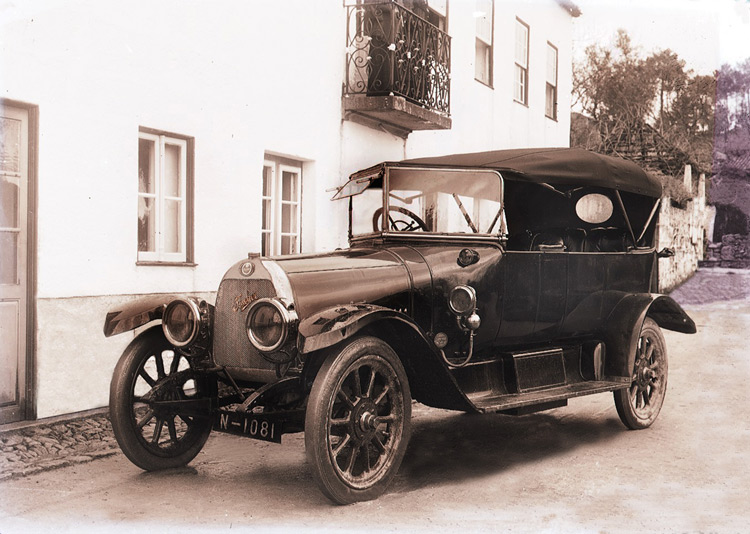
This is a very lovely looking car of somewhat Tutonic
appearance with a V-ed windscreen which is split on the driver's side and has an
openable top driver's section. It seems to have carbide headlamps and electric
built-in scuttle sidelights, and an electric horn. The front mudguards also have
stylishly v-ed front. It has a very unusual scuttle fuel filler cap in a body
section that seems to look like a fuel tank between the scuttle and the bonnet.
The bonnet is circular in shape with a very high hinge line, questioning the
possibility of opening both sides of the bonnet simultaneously. Handle just
visible for lifting the bonnet sides but no clear sight on the photo of the
number or spacing of the louvers. The radiator is slightly bell shaped, oval at
the top with a circular indiscernible badge. The header tank is stylishly
slightly sloping back from the radiator front. A neatly built-in battery
/toolbox case is in the skirt/running board, and an inspection plate not big
enough to suggest chain drive is at the rear of the running board. Semi elliptic
springs with no sign of front brakes. The roof is 'convertible' and neatly
fitted to the windscreen but not clear as to how waterproof. It seems to be of
the 'one-man' variety roof hood, allowing one man to take it up or down without
central stays, but resulting in probably head-butting the sagging cross support
on entry-exit.
Days of much fruitless searching followed leafing through books and trawling
the internet but northing came up until a chance stumble onto a philatelist
website featuring sets of automobile postage stamps. There we came across a
Swiss 2015 Helvetia stamp that showed a car that the website named as a '1908
Turicum from Switzerland'. This looked exactly alike to our car, so confirmed
that we were on the right track; a Swiss stamp showing a car from Switzerland
involving two Swiss car manufacturers Turicum and Fischer. Enlarging the small
size photo did not reveal the badge but the artistic background suggested a logo
and the name Fischer.
 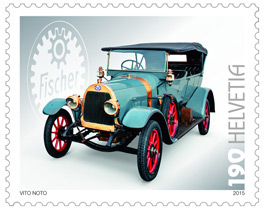
So what does Turicum have to do with it? Well, it seems that Turicum was a
follow-on company to an earlier enterprise founded in 1904 by a Swiss Martin
Carl Fischer under his own name. Fischer was born in 1866 in Zurich and became a
successful watchmaker but seemed intrigued by developments of 'automobilism' and
started carrying out his own experiments with some impressive original
thinking. He built a type of buckboard single-seater vehicle with small wheels
and with the engine at the front. It had chain drive to rear wheels, and
steering was with the feet directly steering the front axle. The thinking behind
the design was that it would fit through a standard doorway and could be carried
up and stored in a flat!
 
The second version of the machine used a leather
covered cone friction drive disc arrangement as a clutch/gearbox before the
chain drive, and had a rudimentary body. The photo below shows Martin Fischer
driving his machine. 'Look mum. - no hands!!"
 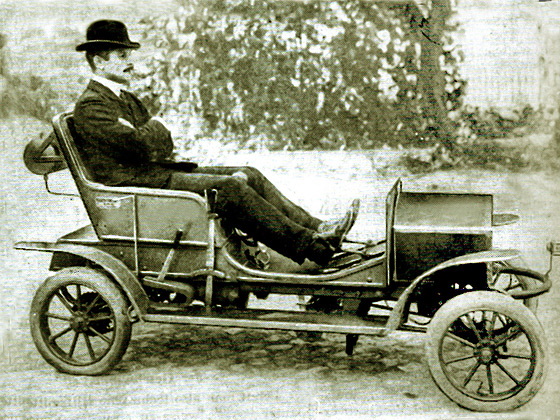
In 1905 he designed a more conventional small car which he named 'Turicum',
which was shown at the Paris Salon and created some interest. With backing from
partners he formed a new company ' Automobilfabrik Turicum ' in 1907. Turicum is the
Roman word for Zurich. Confident in his designs he at the same time filed a
number of patents locally as well as in USA for his steering system and the
friction drive system.
The Model A Turicum had an air cooled single cylinder
785cc engine and with Friction drive, which remained a Turicum feature.
It had a false radiator which acted as a fuel tank. In 1907 the 10/12 hp model
with four-cylinder engine of 1385 cc was introduced, and the single-cylinder
model had its engine enlarged to 1045 cc. Two and four-seat, open and closed
bodies were offered.
 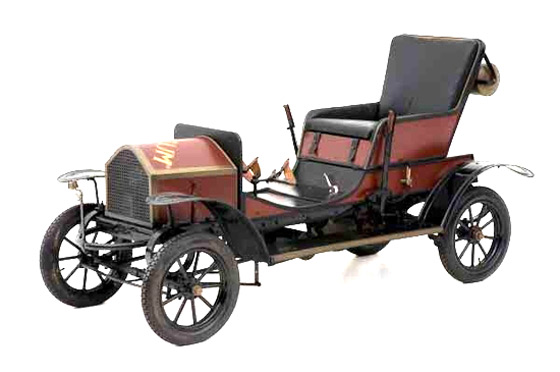
In 1912 a 16/26 model with 2613 cc engine was announced
which was offered with a conventional gearbox. Water cooled and four
cylinder versions also became available. Various models and various body styles followed
with conventional gearboxes. Cars met with success and a second factory was built
at Uster near Zurich. A company was formed in Paris and agencies were appointed
in Europe, South America and South Africa.
There was also a totally separate company in Slatinany
in Czechoslovakia, Slatinanske Tovarny Automobilu RA, otherwise a manufacturer of fire engines, which marked, as
their own, a light car which was actually an assembled version of the Model D
8'18 Tericum car from Uster. (Picture of a Model D Turicum is shown below as
received in 2020 from one of our an enquirer in Sweden for identification,)
 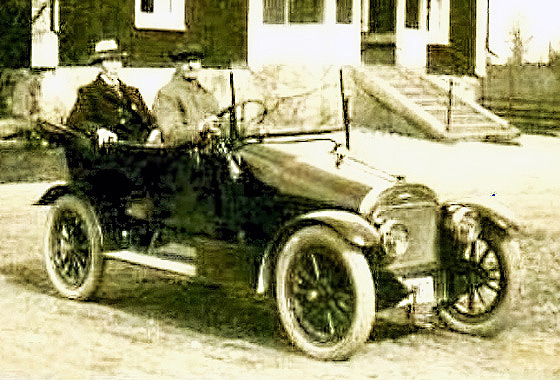
Martin Fischer left the Turicum organisation in September 1907 to form
Fischer Wagen AG in Zurich. Turicum carried on successfully with increasing
production of over 200 chassis annually up to World War One when it encountered financial
problems. It stopped production in 1912, - but remained on the books until 1925.
A c1909 Turicum 16CV Tourer is shown below.
 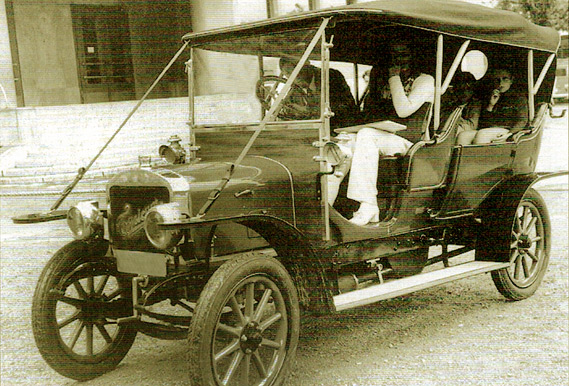
Martin Fischer continued with his innovative developments and designed two
other revolutionary concepts which he patented locally and in the United States.
He developed a "side-controlled slide monoblock engine" (variation on
a sleeve valve engine and one of the first engines to have all cylinders cast as block.)
and an "internal gear selection mechanism" (a type of epicyclic
gearbox). The engine was shown at the Berlin Motor Show in 1911 and a number of
European car manufacturers acquired licences to manufacture, including
Dealaugere & Clayette, De Bazelaire, and the American company Aristos of New
York City for their proposed luxury car 'Mondex-Magi '.
 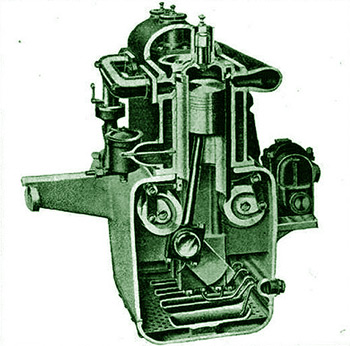
Having left Turicum, Fischer-Wagen was formed in 1908 with help from a silk manufacturer.
The
first car was very much a carry-over of the Turicum car. This was a 14'16 four
cylinder 2009cc Torpedo with friction disc transmission and chain drive, made in
conjunction with Weidmann of Zurich. Some 70 cars were made 1909-10 which
enabled Martin Fischer to bring out his much more revolutionary car in 1911.
 
This had his new sleeve valve 4 cylinder monoblock engine with two shafts with
elliptic curves in the sump actuating crescent shaped sleeves on either side of
the cylinders. The engine was 2722cc at 35HP. The vehicle was also fitted with
his new 4 speed internal gearing gearbox which had gears facing inward rather
than outward; the representation of which later became the logo on the radiator badge
of the car we are investigating - annular gear inside which is a sun-wheel.
 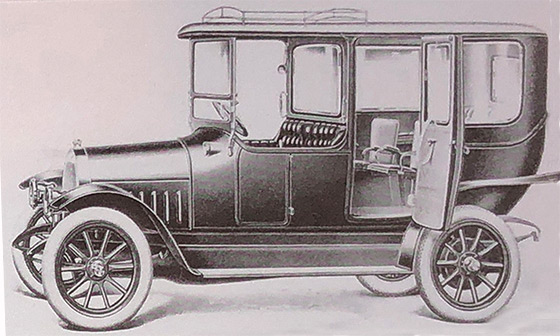
It
was at this time, about 1911, that they changed the shape of the radiator from square to
oval. The
name of the company was changed to Automobilfabrik Brunau. Production in 1911-13 was about 200 cars, mostly sold to Germany, Great
Britain and Brazil. Dealaugere & Clayette signed a licence for France where
they exhibited the 24HP with a new body by Gangloff built by Bazelaire at the
Paris 1913 Salon. Dealaugere & Clayette subsequently sucessfully used the
Fischer engine to after WW1. Fischer then made two six cylinder cars developing 40bhp from
4084cc which had his new sleeve valve monoblock engine.
 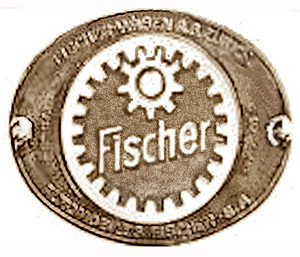
From the very beginning Martin Fischer was looking at the bigger picture and
looked at international markets for his innovations. He was very closely
connected with two companies in New York administering the Fisher patents in the
USA. One was the Motor and Gear Improvement Company, the other was Martin Fischer
Motor Corporation, the latter was based in Church Street, Lower Manhattan. A rather
macabre note is that Church Street was the location of where the World Trade
Centre buildings were erected in 1973, and subsequently destroyed on September
11, 2001 when highjackers flew two Boeing aircraft into the Twin Towers,
demolishing both.
 
Martin Fischer's connection with the United States further consolidated when
in 1914 he signed an agreement with the 'Aristos' Company of New York to build and
market the Fisher cars in the US. Aristos was a manufacture of accessories for
motor vehicles and had various other products under the Mondex name, including
car polishes. The
agreement was that a separate company would be formed to market the 40 and 60HP
Fischer slider engine cars as expensive up-market "Mondex Magic", both
bodied as touring cars. Manufacture of the vehicles was to be undertaken by Palmer and
Singer of Brooklyn, as shown below. They were to make a smaller car of 40HP from 4,2 litres and the bigger car
of 60HP from 7 Litres. Unfortunately the venture was short lived because of the
earlier death of Henry U. Palmer and the subsequent material shortage caused by
the start of World War 1. This also contributed to the collapse of the Mondex
company and the Mondex Magic.
 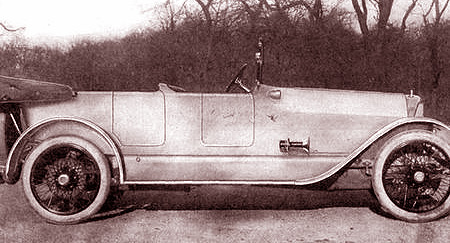
World War One was also the final curtain for the Turicum and Fischer
companies. Turicum ran into financial difficulties and closed down in 1914.
Fischer-Wagen likewise had to close the Swiss factories in 1914. Martin Fischer survived
the war and remained in touch with the motor industry, There was an
attempt in 1919 of a restart between the Swiss SIG of Neauhaussen to develop a
small cyclecar with a MAG V2 motorcycle and Fischer friction drive. After a few
prototypes, this seems to have stopped by 1922 with possibly no vehicles made.
Martin Fischer died in
1947 aged 81.
 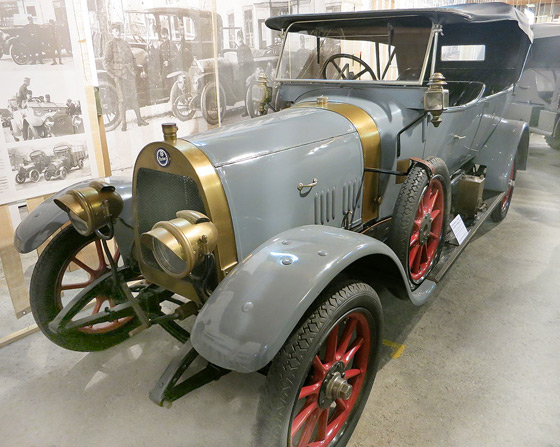
Despite what is actually a very interesting history involving Martin Fischer,
not very much is written or known about the man or the cars. Very few cars in reality
were built under the stewardship of Martin Fisher across his four companies
which built cars. It is believed that no more than about 400 vehicles were
made. Surprisingly, therefore, a handful remain. A couple of Turicum vehicles
are in museums and some remain in Road use, and a 1913 Tourer, as above, can be seen
at the Swiss Transport Museum in Lucerne. This car is dated variously as 1913 or
1914, and described variously as a Fischer 10'28 or as a Fischer 16'20. No further information about it is
shown. What is noticeable is that other photos of the 16'20 show a conventional
bonnet, whereas only this photo has the 'brass' fuel tank band between the
bonnet and the scuttle. We have contacted several sources in Switzerland to
obtain positive identification , but as yet we have not received
any information from any of them.
 
So what is the car shown on the enquiry photo. To be quite honest, at this
stage we do not precisely know, It is indeed a Swiss Fischer very similar to the
one exhibited at the Swiss Transport Museum at Lucerne. It is a big car and it has the waistband fuel
tank which other photos of the 1913'14 Fischer SS 30 and SS 35 Tourers do not
have. Lacking any other evidence, we are therefore left with the possible conclusion that
this could be one of the two 1914 Fischer SS 40 Six Cylinder 40 HP sleeve
valve Torpedos. No further Fischer cars were made after that date so, at
the very least, this must be one of the very last of them !
Go to Recent
SVVS Venues
Page
PICTURE GALLERY INDEX
The information contained in this
article has come from many different sources including books, magazines,
advertisements, sales brochures, web sites, manufacturers data and
personal contacts. While we have tried to make sure that any information given
is as accurate as possible, we cannot take responsibility for any errors or
omissions. If you know of any facts which are incorrect or any subjects,
or details which can be elaborated on, please contact us. No
infringement of copyright is intended anywhere on the site which is a fully
not-for-profit free educational research facility. If such infringement is
believed to be occurring, please contact us.
|